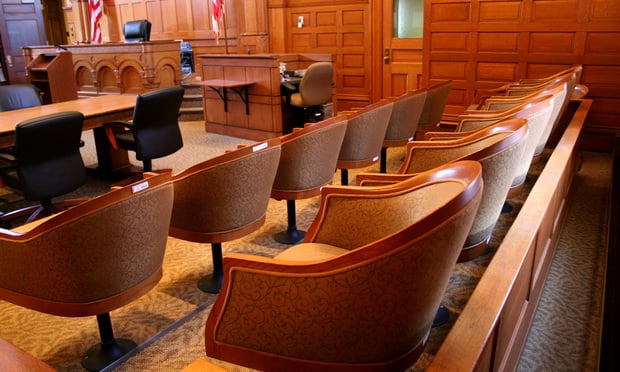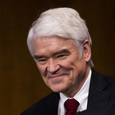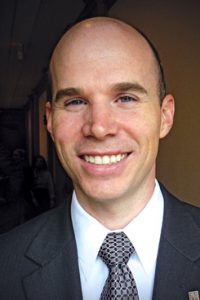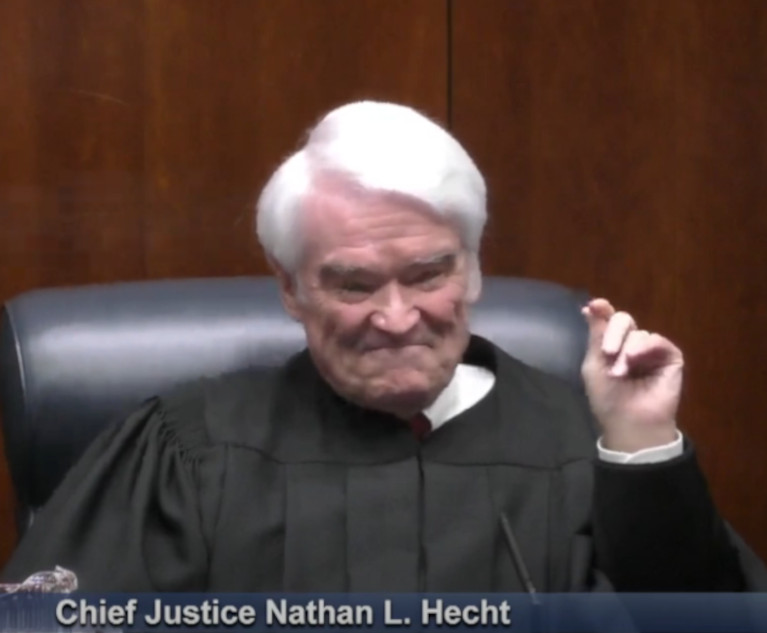Texas Jury Trials to Resume This Summer Under Experimental Program
Jury trials won't resume in Texas on a wide scale until Aug. 1, but in the meantime, the Texas judiciary will authorize some trial judges to hold experiments with conducting jury trials--either in-person or remotely--as long as they have a plan to keep everyone safe from COVID-19 infection.
May 27, 2020 at 03:51 PM
7 minute read
 Photo: Frances Twitty/iStockphoto.com
Photo: Frances Twitty/iStockphoto.com
This summer, select Texas trial courts will conduct experiments to determine best practices to start holding jury trials again while keeping all court participants safe from infection by COVID-19.
The experiments will cover ways to conduct jury trials both remotely and in-person — or perhaps a hybrid of both — following guidelines for social distancing and other infection control measures.
Experimental jury trials were authorized in a Texas Supreme Court emergency order released Wednesday. Even though the high court previously allowed courts to reopen to some in-person proceedings by June 1, in this new 17th emergency order, the justices made it clear that most jury trials are prohibited until Aug. 1. The exceptions are the jury trials that are part of the summer experiments.
 Chief Justice Nathan Hecht. Photo: Diego M. Radzinschi/ALM
Chief Justice Nathan Hecht. Photo: Diego M. Radzinschi/ALMTexas Supreme Court Chief Justice Nathan Hecht said that instead of opening the whole state to jury trials, Texas decided to conduct these experiments in a controlled fashion to avoid a scenario that played out in Ohio in late April.
A judge called a criminal case for a jury trial, only to cancel the proceeding because the defendant experienced difficulty breathing and went to the hospital. He and his criminal-defense lawyer were quarantined.
Read more: Ohio's First Post-COVID Jury Trial Was Set to Begin. Then the Defendant Nearly Collapsed
"It was a fiasco. Not only was it a waste of time, it was possibly infringing on the criminal-defendant's rights, and in any event, was threatening the participants' safety," Hecht said. "The preeminent issue is always the safety of the participants–and principally, the jurors, who are not volunteers. They are forced to be there."
Jury Trial Experiments
The Texas Supreme Court's 17th emergency order explained that the Texas Office of Court Administration is going to be coordinating with the state's regional presiding judges and county local administrative judges. Together they will allow a limited number of jury trials to proceed.
Here's how it will work:
- First, trial judges must request to conduct a jury trial.
- Judges must show that they have a plan to protect everyone through social distancing, restrictions and precautions against infection.
- The parties in the case will have to give their consent unless it's a nonbinding proceeding.
- The plan must show how to protect the parties' legal rights.
- Also, judges will have to make sure the jurors are giving their full attention to the trial and they're not seeking outside influence.
- In any of the jury trials that are experimenting with remote proceedings, the court is supposed to make sure that all of the jurors have the technology that they need to participate in the trial remotely.
- The administrative office will be observing all of the experimental jury trials. The office will use its observations to write a July 31 report to the Supreme Court. The report will help the high court "to develop best practices for other courts' use," said the emergency order.
Before participating in one of Texas' jury trial experiments, a trial judge must come up with a plan to keep people safe during the proceeding.
It's hard to predict what the Texas jury trial experiments will look like, Hecht said. He guessed that courts may come up with hybrid plans that use some remote proceedings mixed with some in-person proceedings.
"You've got to consider personal interaction, personal dynamics — all of the aspects that every good jury trial lawyer knows are important — and how to accommodate them," he said.
The high court's order told the Texas Office of Court Administration to observe each experimental trial that happens this summer and then write a report of recommendations for new jury trial procedures.
David Slayton, administrative director of the office, said he's expecting between 20 to 25 experimental jury trials to happen between now and Aug. 1.
He explained that any in-person jury trial in the experiment is going to have to ensure the right social distancing. For example, jury selection may need to move to a large community center, or a stadium.
"A large pool of people come together. The only way it could happen is in an extremely large room," Slayton said.
After the jury pool was qualified and broken down into jury panels for voir dires in individual cases, that jury selection would also need to happen in a big room where people can spread out. People will probably wear face coverings. Slayton noted that it could be hard for a judge, court reporter and attorneys to hear people in the back of a large room. Judges will have to find some solution to that acoustics problem, he said.
Once lawyers have picked their juries, there's a new problem. Jury boxes in existing courtrooms do not comport with social distancing. Courts are talking about putting the jury in courtroom galleries where they can be properly spaced. Slayton added that this makes a new problem: Will the jurors watch the backs of lawyers' heads during the trial, or will courts rearrange the furniture so they can face each other?
Finally, jury deliberations in small jury rooms will not allow people to do social distancing. Instead, judges may need to borrow another court's courtroom for the jury to deliberate, Slayton said.
Texas has already experimented with using Zoom video conferencing for a summary jury trial, which is an alternative dispute resolution procedure with a one-day trial and nonbinding verdict, followed by mediation. Voir dire and the presentation of evidence all occurred over Zoom in that case.
Read more: The Jury and the Screen: Judges, Lawyers Reflect on Texas' Experimental Zoom Jury Trial
 David Slayton. Photo: Angela Morris/ALM
David Slayton. Photo: Angela Morris/ALMSlayton said that he could imagine judges wanting to experiment with video conferencing for a real jury trial. But first, courts need to work out a problem: Not everyone has a computer and good internet connection.
He said some courts are talking about creating Zoom kiosks in the courthouse, a community center, or library. Jurors who lack their own technology could report to jury duty there and get help from staff to connect remotely to the jury trial.
People have concerns about doing a full jury trial over a video conference, Hecht said.
"On the one hand, jurors can see the witnesses and the participants on the screen, sometimes better than they can see them in the courtroom," Hecht explained. "On the other hand, televisions aren't the same as real life."
Slayton said he sees potential in a hybrid system.
"Maybe the qualification process and voir dire process is done remotely, and people come to the courthouse for the remainder of the trial," he explained.
This content has been archived. It is available through our partners, LexisNexis® and Bloomberg Law.
To view this content, please continue to their sites.
Not a Lexis Subscriber?
Subscribe Now
Not a Bloomberg Law Subscriber?
Subscribe Now
NOT FOR REPRINT
© 2025 ALM Global, LLC, All Rights Reserved. Request academic re-use from www.copyright.com. All other uses, submit a request to [email protected]. For more information visit Asset & Logo Licensing.
You Might Like
View All
ExxonMobil Sues California AG Bonta, Environmental Groups for Advanced Recycling 'Smear Campaign'

2 Judges: Meet the New Chief Justice and the GC Who Just Rose to the Bench
3 minute read

Trending Stories
- 1Meta Pulls Plug on DEI Programs
- 2On the Move and After Hours: Meyner and Landis; Cooper Levenson; Ogletree Deakins; Saiber
- 3State Budget Proposal Includes More Money for Courts—for Now
- 4$5 Million Settlement Reached With Stone Academy
- 5$15K Family Vacation Turned 'Colossal Nightmare': Lawsuit Filed Against Vail Ski Resorts
Who Got The Work
Michael G. Bongiorno, Andrew Scott Dulberg and Elizabeth E. Driscoll from Wilmer Cutler Pickering Hale and Dorr have stepped in to represent Symbotic Inc., an A.I.-enabled technology platform that focuses on increasing supply chain efficiency, and other defendants in a pending shareholder derivative lawsuit. The case, filed Oct. 2 in Massachusetts District Court by the Brown Law Firm on behalf of Stephen Austen, accuses certain officers and directors of misleading investors in regard to Symbotic's potential for margin growth by failing to disclose that the company was not equipped to timely deploy its systems or manage expenses through project delays. The case, assigned to U.S. District Judge Nathaniel M. Gorton, is 1:24-cv-12522, Austen v. Cohen et al.
Who Got The Work
Edmund Polubinski and Marie Killmond of Davis Polk & Wardwell have entered appearances for data platform software development company MongoDB and other defendants in a pending shareholder derivative lawsuit. The action, filed Oct. 7 in New York Southern District Court by the Brown Law Firm, accuses the company's directors and/or officers of falsely expressing confidence in the company’s restructuring of its sales incentive plan and downplaying the severity of decreases in its upfront commitments. The case is 1:24-cv-07594, Roy v. Ittycheria et al.
Who Got The Work
Amy O. Bruchs and Kurt F. Ellison of Michael Best & Friedrich have entered appearances for Epic Systems Corp. in a pending employment discrimination lawsuit. The suit was filed Sept. 7 in Wisconsin Western District Court by Levine Eisberner LLC and Siri & Glimstad on behalf of a project manager who claims that he was wrongfully terminated after applying for a religious exemption to the defendant's COVID-19 vaccine mandate. The case, assigned to U.S. Magistrate Judge Anita Marie Boor, is 3:24-cv-00630, Secker, Nathan v. Epic Systems Corporation.
Who Got The Work
David X. Sullivan, Thomas J. Finn and Gregory A. Hall from McCarter & English have entered appearances for Sunrun Installation Services in a pending civil rights lawsuit. The complaint was filed Sept. 4 in Connecticut District Court by attorney Robert M. Berke on behalf of former employee George Edward Steins, who was arrested and charged with employing an unregistered home improvement salesperson. The complaint alleges that had Sunrun informed the Connecticut Department of Consumer Protection that the plaintiff's employment had ended in 2017 and that he no longer held Sunrun's home improvement contractor license, he would not have been hit with charges, which were dismissed in May 2024. The case, assigned to U.S. District Judge Jeffrey A. Meyer, is 3:24-cv-01423, Steins v. Sunrun, Inc. et al.
Who Got The Work
Greenberg Traurig shareholder Joshua L. Raskin has entered an appearance for boohoo.com UK Ltd. in a pending patent infringement lawsuit. The suit, filed Sept. 3 in Texas Eastern District Court by Rozier Hardt McDonough on behalf of Alto Dynamics, asserts five patents related to an online shopping platform. The case, assigned to U.S. District Judge Rodney Gilstrap, is 2:24-cv-00719, Alto Dynamics, LLC v. boohoo.com UK Limited.
Featured Firms
Law Offices of Gary Martin Hays & Associates, P.C.
(470) 294-1674
Law Offices of Mark E. Salomone
(857) 444-6468
Smith & Hassler
(713) 739-1250






